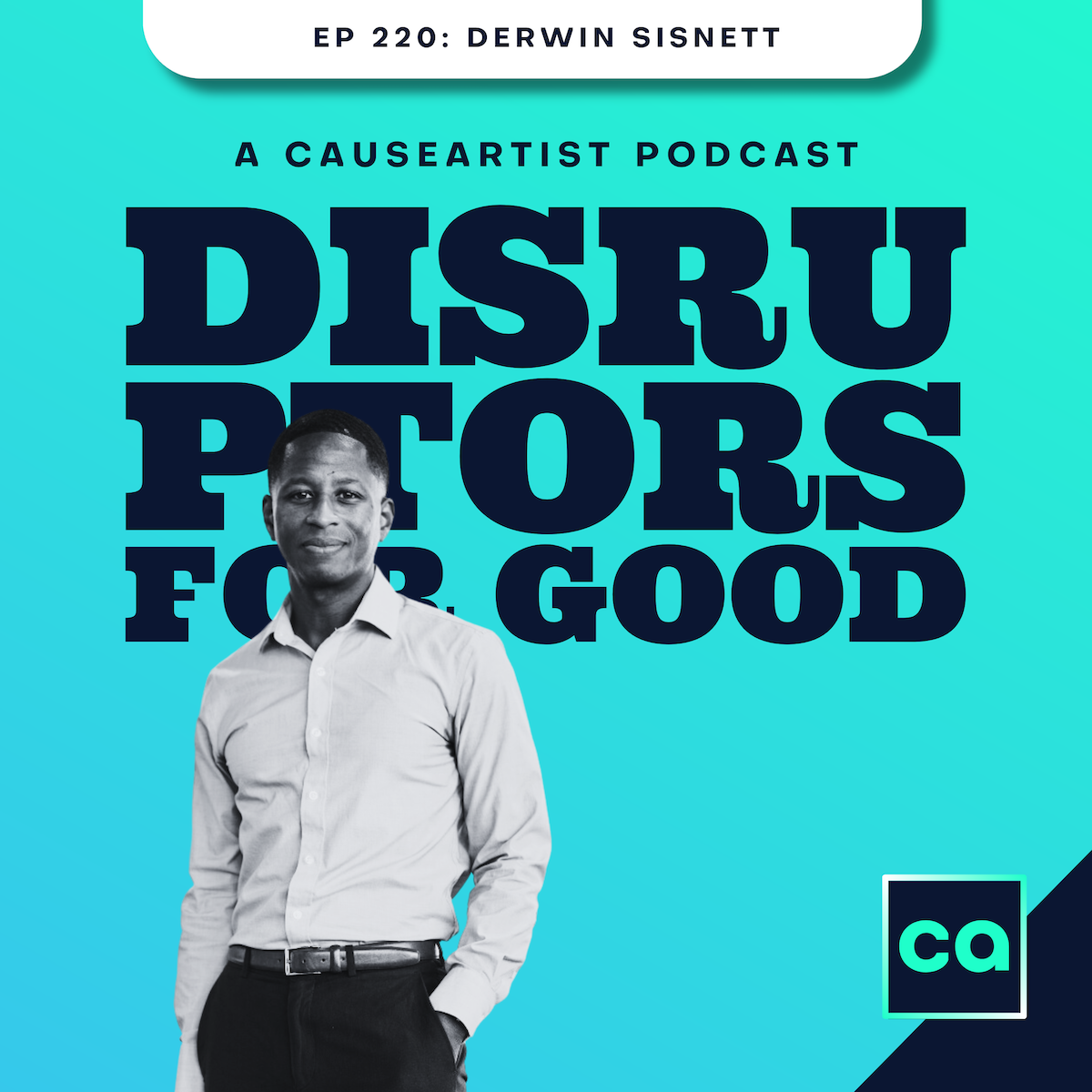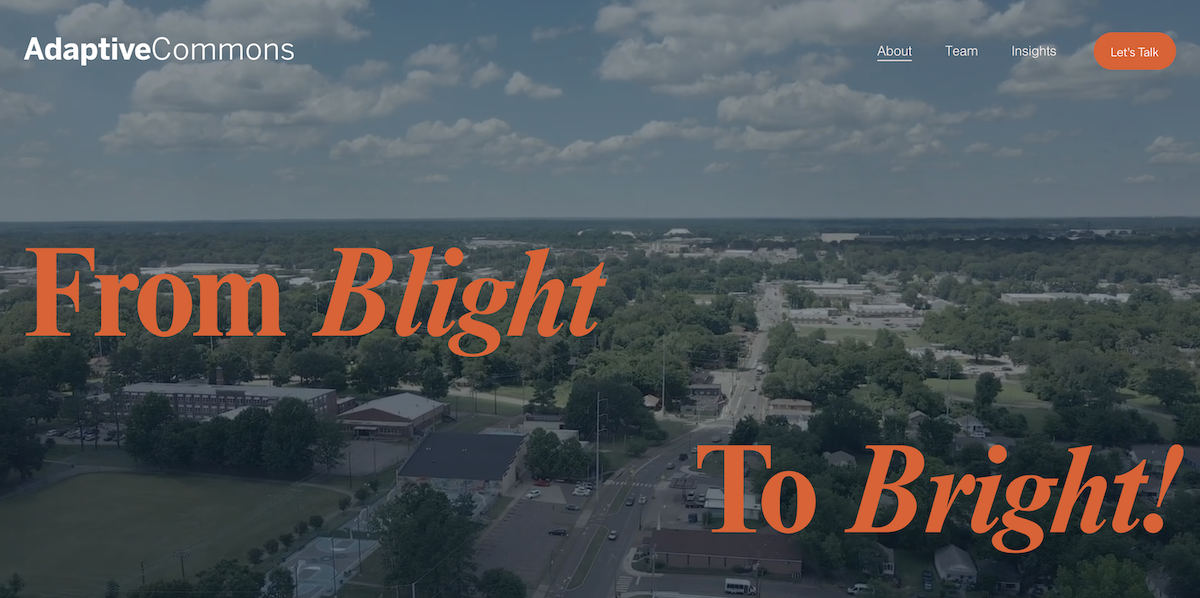In episode 220 of the Disruptors for GOOD podcast, I had the pleasure of speaking with Derwin Sisnett, Founder and CEO of Adaptive Commons, on addressing the urgent need for affordable housing for essential workers by reimagining and rebuilding forgotten spaces into high-quality homes.
- Subscribe on Apple Podcasts
- Subscribe on Spotify
- Subscribe on Amazon Music
About Derwin Sisnett
Derwin Sisnett is the founder and CEO of Adaptive Commons, a real estate development and investment firm focused on transforming public spaces for the greater good.
Before establishing Adaptive Commons, Derwin co-founded and led Maslow Development Inc., a firm dedicated to advising, designing, and developing mixed-use communities centered around high-quality schools.
As the co-founder and former CEO of Gestalt Community Schools, a charter management organization in Memphis, Tennessee, Derwin played a crucial role in developing a network of high-performing, community-based charter schools.
His leadership earned recognition from the White House and the U.S. Department of Education, and he spearheaded a mixed-use development encompassing over 40 acres, which included a performing arts center and affordable housing.
In partnership with the Menkiti Group, Derwin co-founded the Obsidian Catalyst Fund, a real estate investment vehicle under Grove Social Impact Partners, aimed at empowering Black real estate developers and driving neighborhood-level social impact.

His work has garnered attention in major publications such as the Urban Land Institute’s Urban Land Magazine, The New York Times, and the Wall Street Journal.
He has also lectured at the Harvard Graduate School of Design, Yale School of Management, and the University of California, Berkeley, where he serves as a Faculty Lecturer in Real Estate Development and Design.
Notably, he served on the board of the Collage Dance Collective, one of the largest Black-led performing arts organizations in the American South, and played a key role in the adaptive reuse of the historic Sears distribution center, Crosstown Concourse.
In 2015, he became the youngest chair of the board at Memphis Light, Gas and Water, the nation’s largest tri-tier public utility.
Derwin earned his bachelor’s degree from Emory University and holds a PhD from the University of Memphis.
He is also an alumnus of Harvard University’s Graduate School of Design, where he was honored as a Loeb Fellow. Additionally, he is a recipient of the Echoing Green Fellowship and a Pahara Fellow of the Aspen Global Leadership Network, recognized as a Braddock Scholar.
Takeaways
- Derwin's upbringing in Far Rockaway shaped his understanding of the built environment.
- The importance of community engagement in real estate development.
- Adaptive Commons aims to repurpose vacant school buildings for affordable housing.
- Catalytic capital is crucial for bridging funding gaps in development projects.
- Ensuring affordability for essential workers is a key focus of Adaptive Commons.
- Walkability and access to amenities are vital for community well-being.
- The narrative around adaptive reuse needs to shift towards public good.
- Teachers and essential workers deserve affordable, quality housing.
- Gentrification concerns must be addressed to prevent displacement.
- The future of urban development lies in innovative reuse of existing structures.
Why Adaptive Commons?

The need for affordable housing for essential workers is significant across municipalities in the United States. Many essential workers are priced out of housing near their jobs, while numerous vacant buildings jeopardize the viability of city centers.
By adapting existing structures, Adaptive Commons can save up to 40% in emissions, reduce transportation costs, and minimize additional land use. This approach not only supports environmental sustainability but also creates a positive ripple effect in communities.
Investing in workforce housing enhances the lives of essential workers, which in turn benefits the populations they serve and revitalizes the broader community.
The Present Opportunity
The Challenge: Essential workers often cannot afford to live close to their workplaces, exacerbating the affordable housing crisis.
The Solution: Adaptive Commons connects municipalities with turnkey workforce housing solutions through a tailored real estate development and investment platform. This initiative transforms underutilized spaces into modern living environments that cater to the needs of essential workers.
Why Now?
The adaptive reuse of existing municipal structures offers an efficient and sustainable solution to the housing and climate crises facing the nation today. With an increasing focus on environmental responsibility, leveraging existing real estate is both a financially sound decision and a step toward a more sustainable future.
As Will Guidara states, “Intention means every decision, from the most obviously significant to the seemingly mundane, matters.” This philosophy underpins every project undertaken by Adaptive Commons, ensuring that choices made positively impact communities.
Insights: A Legacy of Community Transformation
Adaptive Commons employs proven strategies that meet the needs of essential workers while fostering sustainable, community-centered solutions. The organization aims to create lasting positive impacts that enrich residents' lives and revitalize urban areas.
“Neighborhoods across the US are fractured by design. If we continue to address the need for schools, affordable housing, health and wellness programs, and workforce assets in silos, the problem will only persist.” Derwin Sisnett
Adaptive Commons invites collaboration to further its mission. Together, the goal is to transform spaces and lives, ensuring essential workers can thrive in the communities they serve.
Episode Transcript
[00:00]
Host (Grant):
Welcome to another episode of Disruptors for Good. Today, I'm excited to speak with Derwin Sisnett, the CEO of Adaptive Commons. He has done amazing things throughout his life, especially in the realm of real estate development and revitalizing urban spaces. Derwin, you've worked on some incredible projects that combine education, housing, and community development. Before we dive into Adaptive Commons and all the great work you're doing now, let's start with your journey. You've had a fascinating career path. Walk us through it.
[01:06]
Derwin Sisnett:
Thanks, Grant, and thanks for having me. My journey starts in Far Rockaway, Queens, New York. Far Rockaway shaped a lot of my thinking about the built environment, even though I didn’t know to call it that back then. Growing up in a place with one of the highest concentrations of public housing, combined with being right by the Atlantic Ocean but feeling disconnected from the rest of the city, it gave me an awareness of how environments impact people. When I went to high school outside Far Rockaway, at Townsend Harris, I noticed stark differences in the environment and how it influenced education and opportunities.
After graduate school, I moved to Memphis and founded a charter school called Power Center Academy in a neighborhood similar to Far Rockaway. It was clear that the environment was affecting the community, and while the school was successful, I realized that education alone wasn’t enough. We needed to improve the neighborhood itself. That led me to my first major development project: revitalizing a blighted apartment complex in Memphis called Marina Cove.
[04:27]
Derwin Sisnett:
Marina Cove was a 394-unit apartment complex that had been abandoned and was in such bad shape that the entire property was appraised at only $100. It was declared a public nuisance. But I saw the potential. With no real estate experience—my background was in psychology and creative writing—I gathered a team of experts and learned how to pitch for capital. We raised city grants, got tax write-offs, and eventually bought the property. Along with 19 adjacent acres, we had 43 acres of land, and we were able to create a middle school, a performing arts center, single-family homes with Habitat for Humanity, and even a high school.
[07:07]
Host (Grant):
That’s incredible. You mentioned that Memphis was like the blueprint for what you’re doing now. How did the project in Memphis set the foundation for taking your ideas to other cities like Tulsa and Birmingham?
Derwin Sisnett:
Real estate is local, but the formula remains the same: engage local actors and support their efforts rather than impose something from the outside. In Tulsa, people saw what we did in Memphis and asked us to replicate it. I knew that for it to succeed, it needed to be homegrown. We worked with the local community, helping them behind the scenes to bring their vision to life. We’ve done similar work in Birmingham, and the key to success has been ensuring that we’re not the face of the project but rather supporting local efforts.
[12:19]
Host (Grant):
Let’s talk about Adaptive Commons. Give us the pitch—what’s the mission and vision?
Derwin Sisnett:
Adaptive Commons is about reimagining vacant school buildings for housing, especially for teachers and other essential workers. Across the U.S., many school districts own underutilized or vacant properties. At the same time, teachers can’t afford to live near where they work. So, what if we took these public assets and adapted them for housing? This not only benefits teachers but can also serve firefighters, first responders, and other essential workers. Schools are ideal for adaptive reuse—many have been turned into luxury apartments or hotels, but we want to repurpose them for public good.
[13:58]
Host (Grant):
How do you begin this process? Are there specific steps to identify and transform these properties?
Derwin Sisnett:
There are thousands of vacant schools across the country, many in cities like Chicago and Philadelphia, where mass closures have taken place. We start by working with local developers who are focused on the public good. We identify viable properties, assess the potential for housing, and then bring together the right partners. We focus on projects where we can assemble the necessary capital stack, which includes things like tax credits and philanthropic funding, but there’s often a gap that needs to be filled by catalytic capital.
[18:16]
Host (Grant):
Catalytic capital sounds like a critical part of this. Can you explain how it fits into the overall financial model for Adaptive Commons?
Derwin Sisnett:
Catalytic capital is crucial because it fills the financial gap that traditional investors won’t cover due to the perceived risk. Even if a project costs $100 million and we’ve secured tax credits and city grants, there’s usually a gap—say, $5 million. That’s where catalytic capital comes in, de-risking the project enough for other investors to come on board. Without that gap funding, the whole project could fall apart. Our goal is to create a field where adaptive reuse of school buildings for housing becomes a recognized model.
[21:07]
Host (Grant):
You mentioned affordability earlier. How do you ensure these revitalized properties remain affordable for teachers and essential workers?
Derwin Sisnett:
We aim to serve the “missing middle,” those earning 80-120% of the Area Median Income (AMI). We don’t want to concentrate wealth or poverty—we want a mixed-income community. By using public assets like school buildings, we can keep costs low, but the key is ensuring that the housing remains affordable long-term. We also want to make sure these developments don’t lead to displacement. Keeping a community intact while improving the built environment is critical.
[27:22]
Host (Grant):
Walkability and the mental health benefits of living close to work—are these factors you consider when choosing locations?
Derwin Sisnett:
Absolutely. In every project, we look at walkability and accessibility to basic amenities. It’s not just about proximity to work; it’s also about creating a community that doesn’t rely on long commutes. Teachers and first responders shouldn’t have to drive an hour to get home after a long day. We’ve seen in Memphis how putting a high school next to a struggling business can boost the local economy and help revitalize a neighborhood.
[33:22]
Host (Grant):
It seems like the potential for this model is huge. How does someone interested in adapting a vacant school in their community get started?
Derwin Sisnett:
Start by talking to your local school district or school board. If you see a vacant school building, find out who owns it and what plans exist for it. Then, connect with local developers who are interested in adaptive reuse for public good. We at Adaptive Commons are happy to support those efforts, whether it’s through capital, consulting, or helping to navigate the process.
[39:59]
Host (Grant):
Looking ahead, what do you hope to achieve with Adaptive Commons in the next 5-10 years?
Derwin Sisnett:
We want adaptive reuse of school buildings to be commonplace. Our goal is for people to look at a vacant school and immediately think, “This should be repurposed.” Ultimately, we also want to honor the teaching profession by giving teachers beautiful, affordable places to live near where they work. This isn’t just about real estate—it’s about creating environments where teachers can thrive, and when teachers thrive, so do students and families.
Host (Grant):
Derwin, thank you so much for your time and for the incredible work you’re doing. Best of luck to you and the team at Adaptive Commons!
Derwin Sisnett:
Thanks, Grant. It’s been a pleasure. I appreciate the opportunity to talk about this work.







